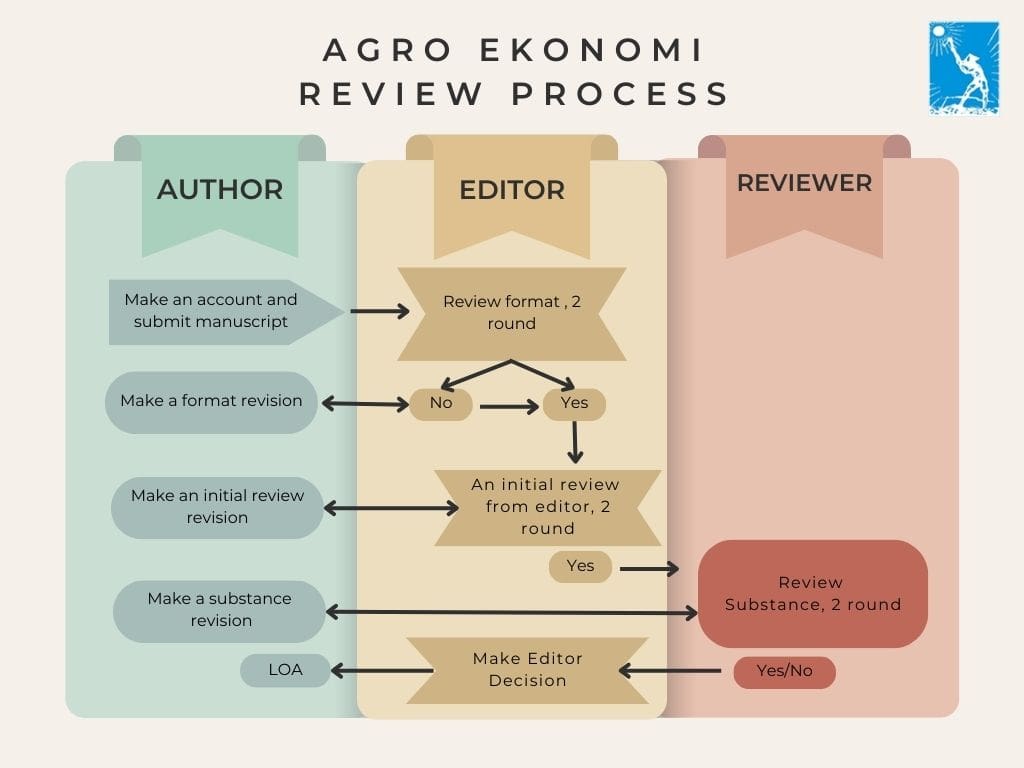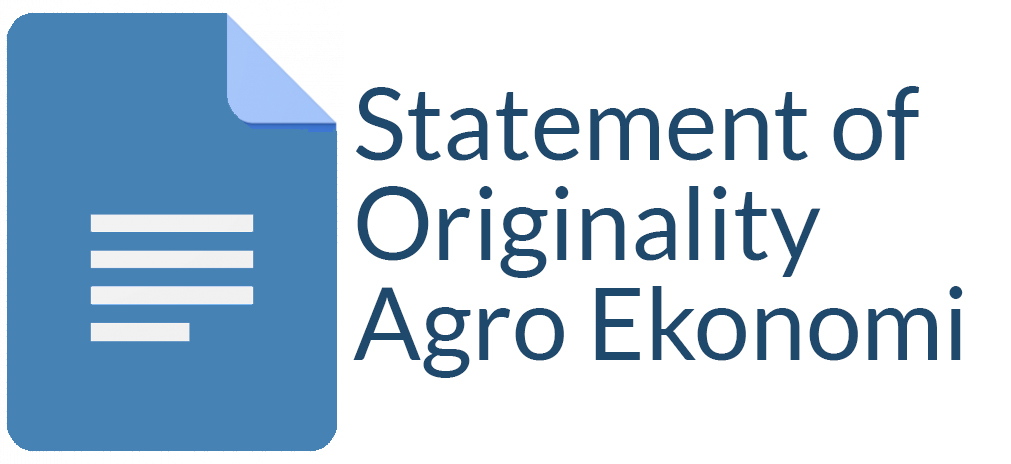Modelling the Relationship between Rice Price, Rice Production, Exchange Rate, and Rice Import in Indonesia
Muhammad Ali Yafi(1*), Amanda Sekar Adyanti(2), Amanda Anggi Purwanti(3)
(1) Master of Sains Agribusiness, Faculty of Economics and Management, IPB
(2) Master of Agribusiness, Faculty of Agriculture, Universitas Jember
(3) Master of Sains Agribusiness, Faculty of Economics and Management, IPB
(*) Corresponding Author
Abstract
Rice is a strategic food commodity for Indonesia. Most Indonesians, 95 percent consume rice as their staple food. However, Indonesia still imports rice to fulfil its domestic rice needs. Dependence on imports is neither good for the short term nor the long term. The purpose of this study is to see the relationship of rice price, rice production, exchange rate to Indonesia's rice import. The data used is time series data with monthly frequency from January 2019 to December 2023 taken from ITC Trade Map, Central Statistic Agency, and Bank Indonesia. The analysis method uses a Vector Error Correction Model (VECM) approach that can provide short-term and long-term information through several tests. The results showed that in the long run the exchange rate and rice production have a negative influence on rice imports. While in the short term, the variables that affect rice imports are the import variable itself and the price of rice in the previous 2 periods, as well as rice production in 1 previous period. The significant influence of rice production requires the government to pay attention to the stock and the amount of imports in balance. Exchange rate, rice price, and rice production variables respond relatively quickly to rice imports. The rice import variable has a large enough proportion in influencing itself followed by the exchange rate, and rice production which has a greater influence each period.
Keywords
Full Text:
PDFReferences
Agriculture, M. of. (2022). Statistik Pertanian Tahun 2022. Jakarta: Pusat Data dan Sistem Informasi Pertanian Kementerian Pertanian Republik Indonesia.
Anam, M. S., Nadila, D. L., & Iskandar, I. (2021). Pengaruh Jumlah Uang Beredar dan Kurs terhadap Harga Beras di Indonesia dengan Inflasi sebagai Variabel Intervening. Jurnal Samudra Ekonomi Dan Bisnis, 12(2), 168–183. https://doi.org/10.33059/jseb.v12i2.2429
Armaini, D., & Gunawan, E. (2016). Pengaruh Produksi Beras, Harga Beras Dalam Negeri dan Produk Domestik Bruto Terhadap Impor Beras Indonesia. Jurnal Ilmiah Mahasiswa (JIM) Ekonomi Pembangunan Fakultas Ekonomi Dan Bisnis Unsyiah, 1(2), 455–466.
Central Statistic Agency. (2024). Luas Panen dan Produksi Padi Indonesia 2018-2023. Jakarta: Badan Pusat Statistik.
Dhamira, A., & Irham, I. (2020). the Impact of Climatic Factors Towards Rice Production in Indonesia. Agro Ekonomi, 31(1). https://doi.org/10.22146/ae.55153
Dinar, L., Faradilla, C., & Marsudi, E. (2023). Analisis Faktor-Faktor yang Mempengaruhi Impor Beras di Indonesia. JURNAL ILMIAH MAHASISWA PERTANIAN, 8(3), 136–151.
Enders, W. (1995). Applied Econometric Time Series. New York: John Wiley & Sons, Ltd.
Estyawan, M. A. P., & Yuliarmi, N. N. (2024). Pengaruh Kurs Dollar, Inflasi Dan Jumlah Produksi Padi Terhadap Impor Beras Indonesia Tahun 1991–2019. E-Jurnal Ekonomi Dan Bisnis Universitas Udayana, 13(02), 366. https://doi.org/10.24843/eeb.2024.v13.i02.p16
Firdaus, M. (2020). Aplikasi Ekonometrika dengan E-Views, Stata, dan R. Bogor: IPB Press.
Gujarati, D. N., & Porter, D. C. (2009). Basic Econometrics. In Introductory Econometrics: A Practical Approach (5th ed.). Ney York: McGraw-Hill.
Hidayat, H., Sukmaya, S. G., & Heryadi, D. Y. (2022). Analisis Integrasi Pasar Cabai Merah Besar di Kota Tasikmalaya. Jurnal Ekonomi Pertanian Dan Agribisnis, 6(3), 1051. https://doi.org/10.21776/ub.jepa.2022.006.03.25
Ilham, N., Sumaryanto, Azis, M., Syahyuti, Anwar, K., Sudaryanto, T., … Suharyono, S. (2023). Technical Efficiency of Local Rice Farming in Tidal Swamp Areas of Central Kalimantan, Indonesia: Determinants and Implications. International Journal of Design and Nature and Ecodynamics, 18(5), 1235–1245. https://doi.org/10.18280/IJDNE.180526
International Trade Centre. (2024). Trade Statistics for International Business Development. Retrieved from https://www.trademap.org/
Kinose, Y., Masutomi, Y., Shiotsu, F., Hayashi, K., Ogawada, D., Gomez-Garcia, M., … Fukushi, K. (2020). Impact assessment of climate change on the major rice cultivar ciherang in Indonesia. Journal of Agricultural Meteorology, 76(1), 19–28. https://doi.org/10.2480/agrmet.D-19-00045
Kurniawan, P., Safrida, & Mustafa. (2019). Analysis of Factors Affecting Rice Imports in Indonesia. Russian Journal of Agricultural and Socio-Economic Sciences, 91(7), 97–101. https://doi.org/10.18551/rjoas.2019-07.10
Muhlis, M., & Nababan, B. O. (2021). Intergrasi Pasar Beras Vertikal Antara Petani dan Pedagang Grosir Di Indonesia. Jurnal AGRISEP: Kajian Masalah Sosial Ekonomi Pertanian Dan Agribisnis, 20(2), 227–238. https://doi.org/10.31186/jagrisep.20.2.227-238
Nizar, J., & Abbas, T. (2019). Faktor – Faktor yang Mempengaruhi Impor Beras di Indonesia Tahun 1980-2009. Economics Development Analysis Journal, 2(1), 31–47.
Onu, D. O., Simonyan, J. B., & Onyenweaku, C. E. (2017). Determinants of Rice Production and Import in Nigeria ( 1970 – 2016 ): An Application of Co-Integration and Error Correction Model. Futo Journal Series, 3(2), 16–34.
Paipan, S., & Abrar, M. (2020). Determinan Ketergantungan Impor Beras di Indonesia. Jurnal Ekonomi Dan Kebijakan Publik, 11(1), 53–64. https://doi.org/10.22212/jekp.v11i1.1443
Rai, A., & Wibowo, S. H. (2020). Analisis Hubungan Impor Beras dengan Produksi Beras, Harga Beras Impor, dan Domestik dengan VECM. Jurnal Matematika, Statistika Dan Komputasi, 16(3), 337–352. https://doi.org/10.20956/jmsk.v16i3.9436
Ramadhan, N. (2024). ARTICLE REVIEW: The Influence Of Climate Change On Rice Production And Cultivation Patterns In Indonesia. Jurnal Agronomi Tanaman Tropika (Juatika), 6(1). https://doi.org/10.36378/juatika.v6i1.3374
Revania, L. (2014). Analisis Faktor-Faktor Yang Mempengaruhi Impor Jagung Di Indonesia Tahun 1982-2012. Jejak, 7(1), 102–112. https://doi.org/10.15294/jejak.v7i1.3847
Sari, R. K. (2014). Analisis Impor Beras Di Indonesia. Economics Development Analysis Journal, 3(2), 320–326.
Sinambela, E., Novi, R., Ktut, M., & Teguh, E. (2023). Analisis Integrasi Pasar Cabai Merah Besar di Provinsi Lampung. Jurnal Ilmu Ilmu Agribisnis, 11(3), 150–157.
Suryana, A. (2014). Toward Sustainable Indonesian Food Security 2025 : Challenges and Its Responses. Forum Penelitian Agro Ekonomi, 32(2), 123–135.
Yanti, M. E., Asaad, M., & Sibuea, M. B. (2020). Model Ekonomi Beras di Sumatera Utara. Sosial Dan Ekonomi Pertanian, 15(2), 51–62.
Article Metrics
Refbacks
- There are currently no refbacks.
Copyright (c) 2023 Agro Ekonomi

This work is licensed under a Creative Commons Attribution-ShareAlike 4.0 International License.
View My Stats











